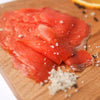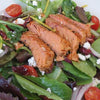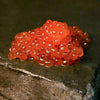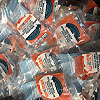There is an exhilaration unknown to many--that is the first set of the commercial salmon season. Often boats are not alone but snuggled up next to each other at the district line, greenhorns and veterans alike pacing the back deck, checking the GPS for time and coordinates, preparing to release 150 feet of plastic mesh into the Bristol Bay brackish river in hopes to bring that net back in, just minutes later, full of the bay’s lifeblood: salmon. During an 8 hour opener on the Egegik River, Steve and the crew aboard the Ava Jane did these moves for the first time of the season last week. They launched the boat out of Naknek on Saturday the 17th, despite being ready on Friday the 16th--following tradition and superstition that Friday is not a day to launch boats and leave harbor, passed down to Steve by a wise and trusted Bering Sea crabber.
The Ava Jane got her 5th taste of the Bristol Bay watershed on June 18th, and the first few salmon rolled into the boat bright and shiny--signs of a life lived out in the open ocean. The weather reminded fishermen across the bay of its strength, and greenhorns searched frantically for their sealegs and sea-stomachs. These are the moments that the Wild for Salmon crew fishes through with grace, hard work and great intentionality of bringing customers the best product possible.

We got this picture of the Ava Jane headed out in a text from crew member Cabot, before they lost their cell service out on the water.
The first couple fishing openers leading up to the longest day of the year--especially long way up north in Bristol Bay!--were about dialing in gear and learning the process for the greenhorns aboard. After a couple stormy first few days--with seas up to 8ft!--the crew was rewarded on summer solstice with calmer weather and a sighting of a gray whale mom and calf parading near the boat. A text from Steve also shared news of a Stellar Eider sighting--big news for bird watchers!
All this is to say, the season is underway!
But what does fishing actually look like? Steve put away the rod that caught the rainbow trout you saw last week and traded it in for his gillnet--a web of diamond-shaped holes stitched together with plastic twine. The reel on the back of the Ava Jane is a bit larger than the one that cranked in Steve’s trout, but it serves generally the same purpose and rolls up the net. But not before the crew gets the chance to pick the fish out and store them in the boat’s icey slush bins.

www.issfoundation.org
In order to catch the volumes of fish needed to supply WFS, the Ava Jane will throw this long mess of plastic off the back of the boat hundreds of times this season. In the water, the small buoys called corks float to the top and the weighted bottom sinks the net, holding the net taut and open against the current. With a huge understanding of the ocean and its particulars, Steve will use the wind, currents, tides, and fish patterns to direct the net rather than his engine as it is a “drift” boat after all. This whole process is called a “set,” and the Ava Jane style of fishing is called drift gillnetting; the net traps the salmon by their gills and the whole unit is adrift in the current, wind and tide during the set.
You can see more behind-the-scenes photos of what our process looks like on this instagram! Some others you might like are: @aksalmonsisters and @alaskaseafood
Because of the regulations by the Department of Fish & Game, the fishing on the east side of Bristol Bay has not yet been blown wide-open as of Saturday the 25th. The WFS crew is fishing openers--6 to 12 hours of setting the net, reeling it in to clean the fish out of it, and putting it back. When the fishing turns to 24/7 it is up to the captain, in our case Steve, to decide when to prioritize sleep over putting the net out. Closely monitoring the bay-wide catch, the weather, travel time and more, boat captains in Bristol Bay are in constant decision-making mode. It is imperative to both keep your crew safe and harvest salmon--but doing both these things requires serious consideration of hundreds factors, from who’s too hungry to pick fish right now to how many fish were caught at Port Moller yesterday.
The Bristol Bay Fisheries Report, broadcasted daily on KDLG, states that the run inis strong--perhaps stronger than ever on the west side in the Nushagak River. The escapement goals (a number set by the fish and game biologists with intentions to continue the full life-cycle of a certain amount of fish returning to the bay in order to support the population) are being met early with great strength on the west side of the bay; this is testament to the efficacy of Bristol Bay’s sustainability practices--the number one reason why we at WFS harvest our catch out of this region. An early run is exciting; a year ago this week, the west side had not even seen half of the current run size yet.
Although the fish have not shown in such droves on the east side yet, our crew is confident that the numbers will be sufficiently strong soon. Steve, Cabot, and the crew are picking away at an impressive daily catch, but they stand ready to fill the boat to the brim. On Monday’s Bristol Bay Fisheries Report on KDLG, biologist Travis Ellison confirmed this confidence, stating that there is no need to panic, even though it is getting to be late June. We were reminded that there are close to 16 million more fish projected to return to the region, and we look forward to welcoming them home as they head upriver.
Catch ya back in 2 weeks for more!
-- Elma





 Wild Alaska Salmon
Wild Alaska Salmon Alaska Salmon Burgers
Alaska Salmon Burgers Smoked Salmon & Seafood
Smoked Salmon & Seafood Wild Alaska Whitefish
Wild Alaska Whitefish Wild Shellfish & Shrimp
Wild Shellfish & Shrimp Wild Albacore Tuna
Wild Albacore Tuna Canned Seafood
Canned Seafood Meal Box & Samplers
Meal Box & Samplers Pet Products
Pet Products Gifts
Gifts Specialty
Specialty Wholesale Ordering
Wholesale Ordering